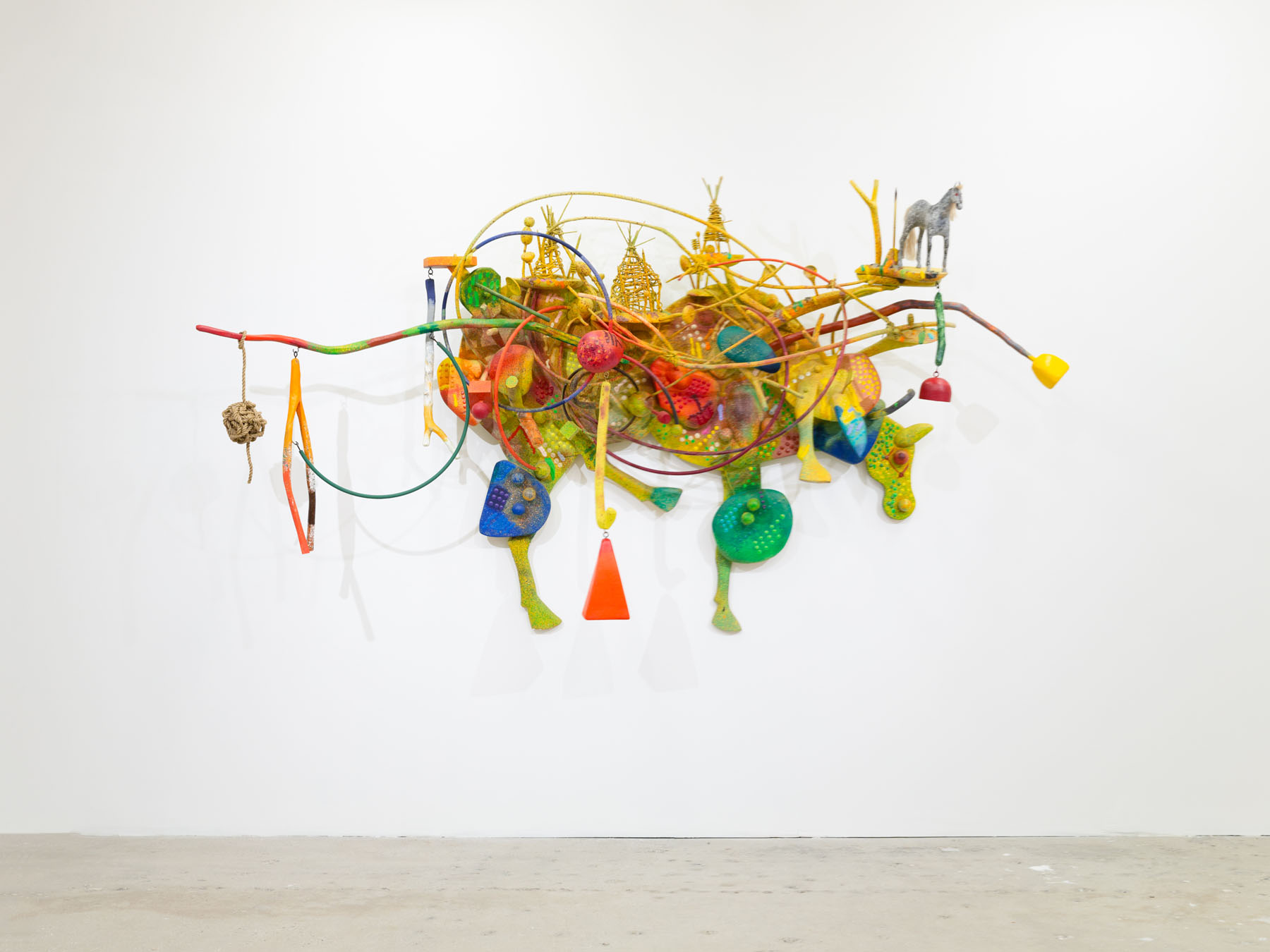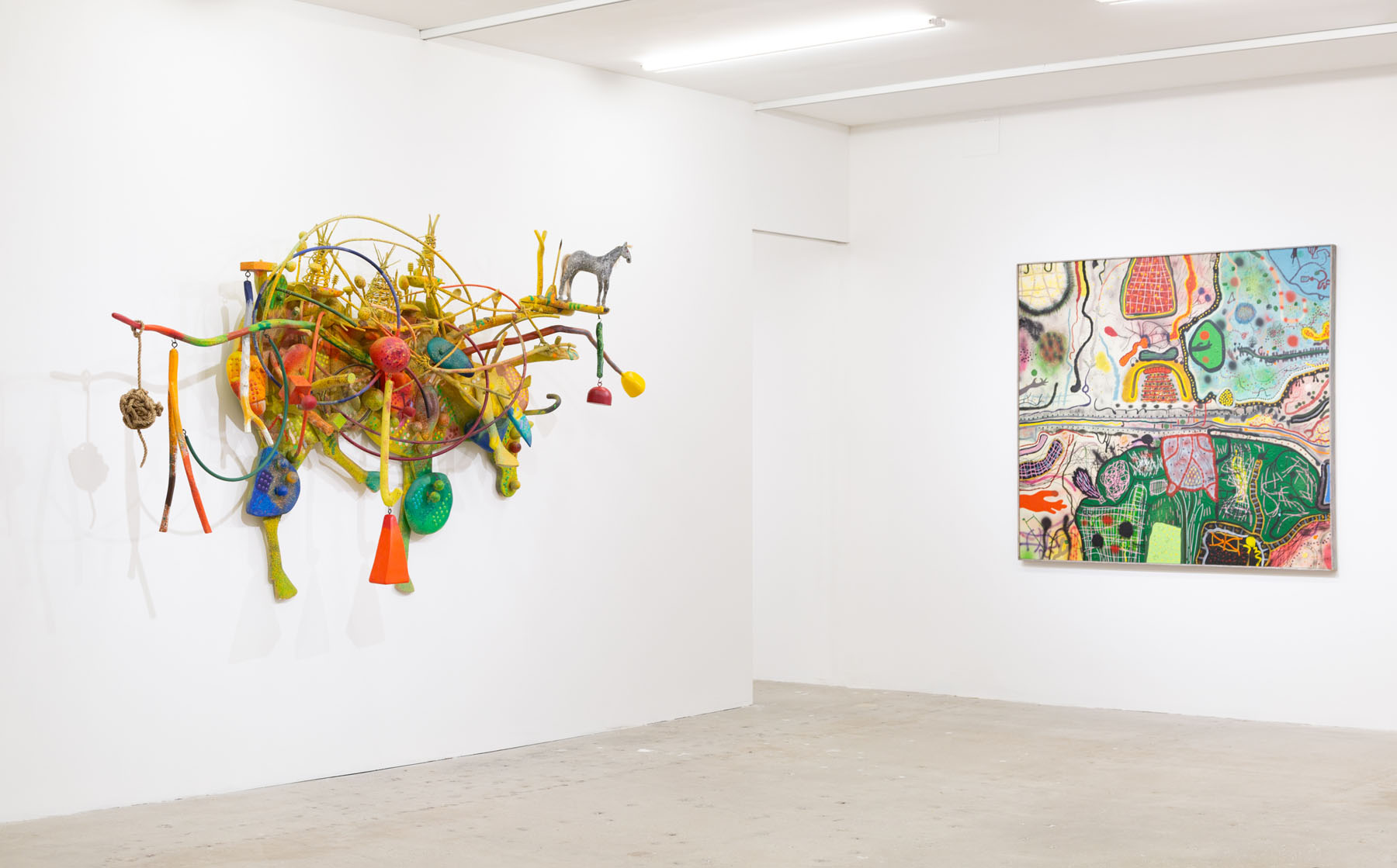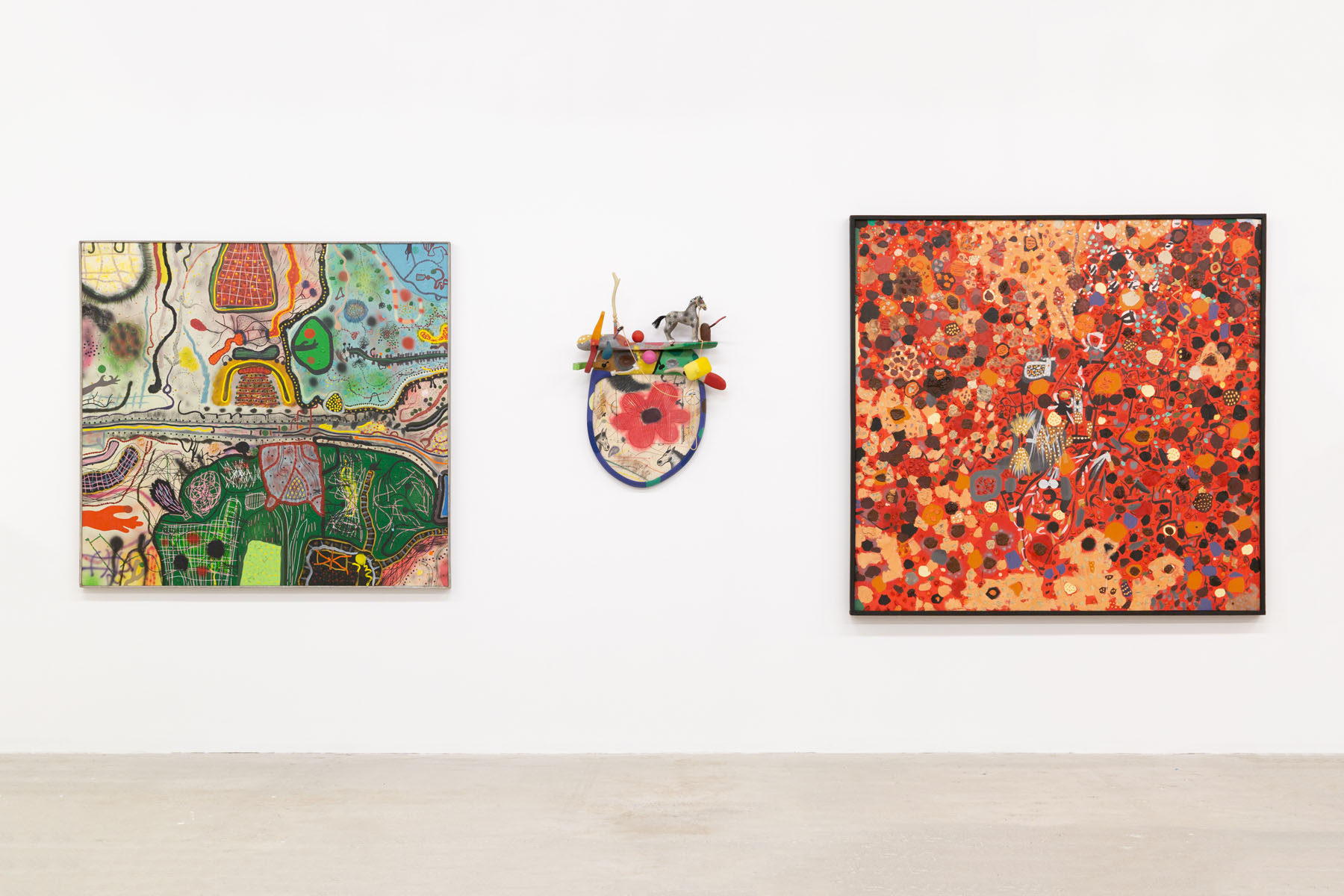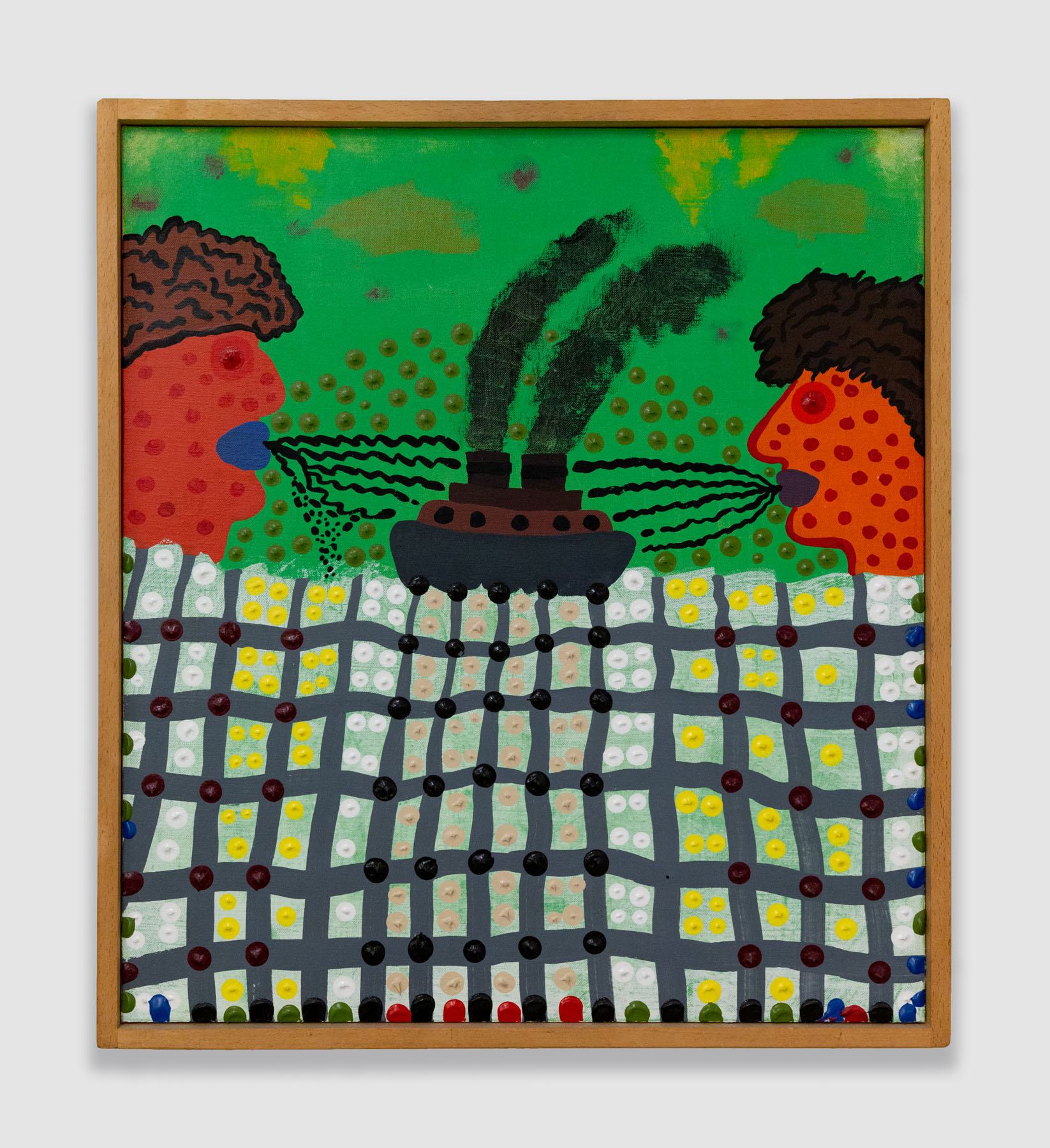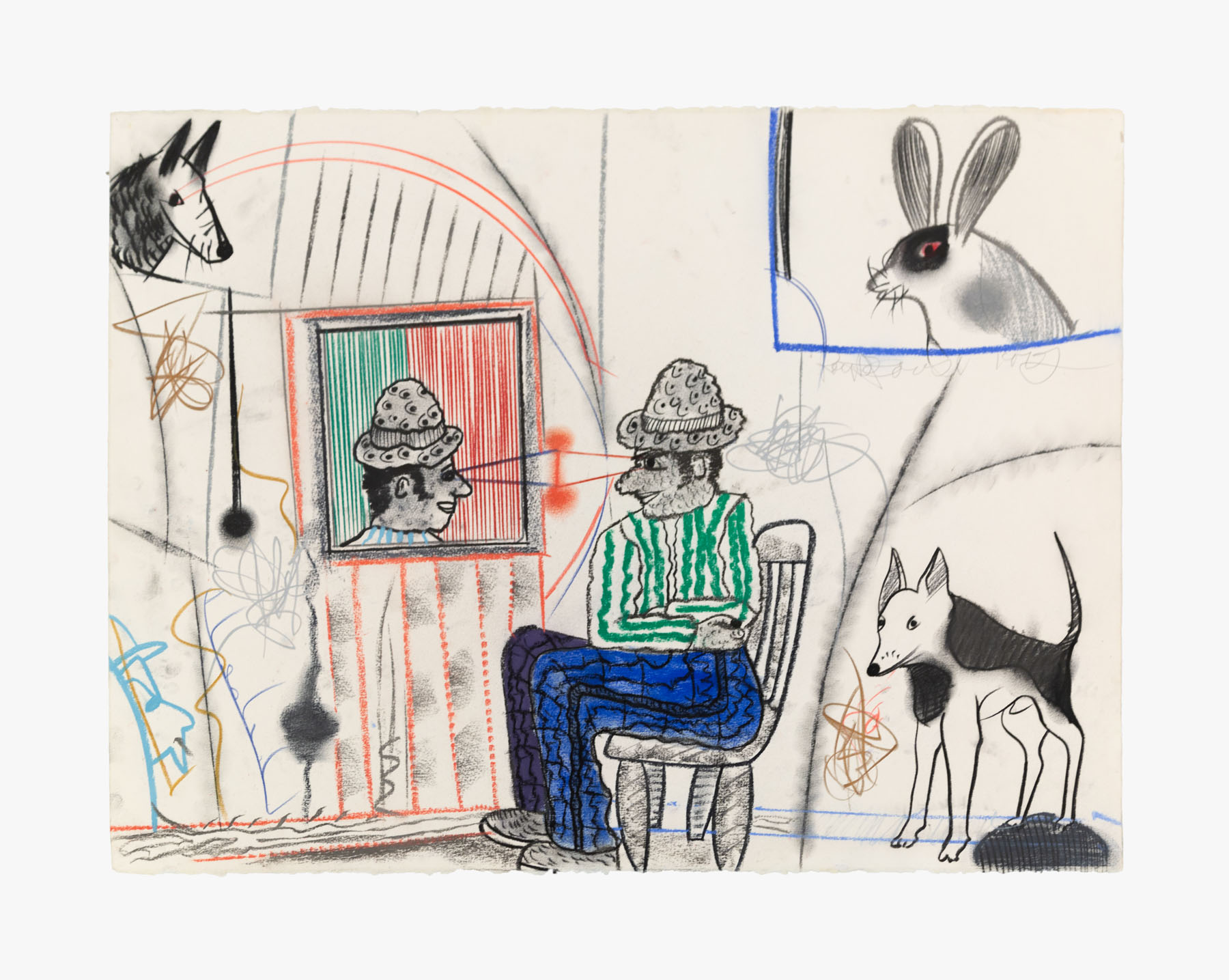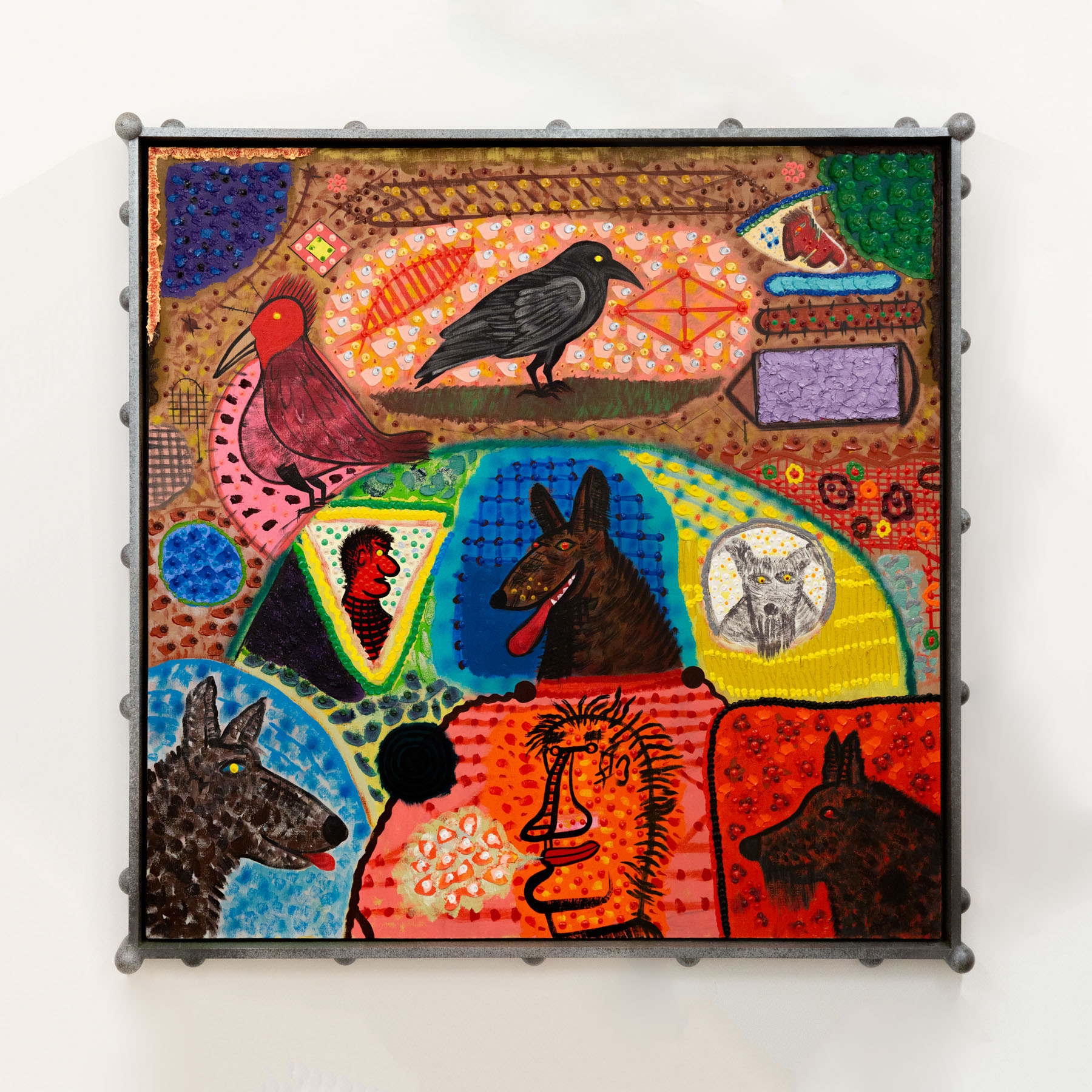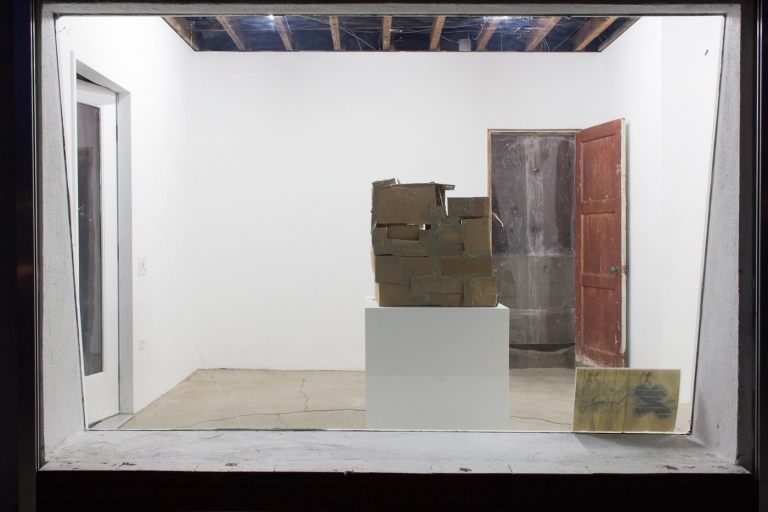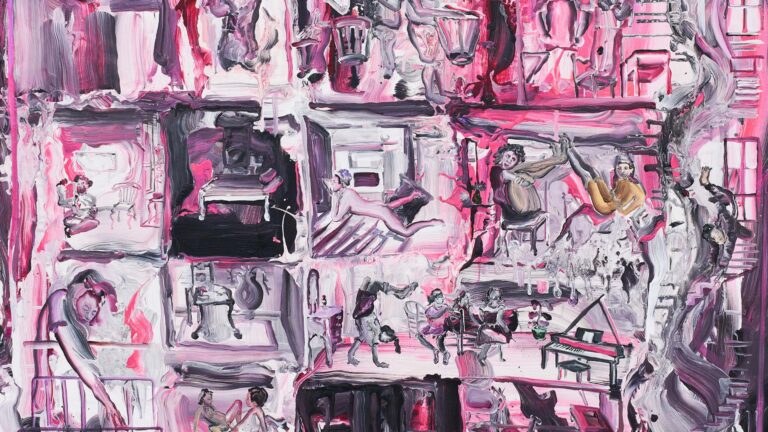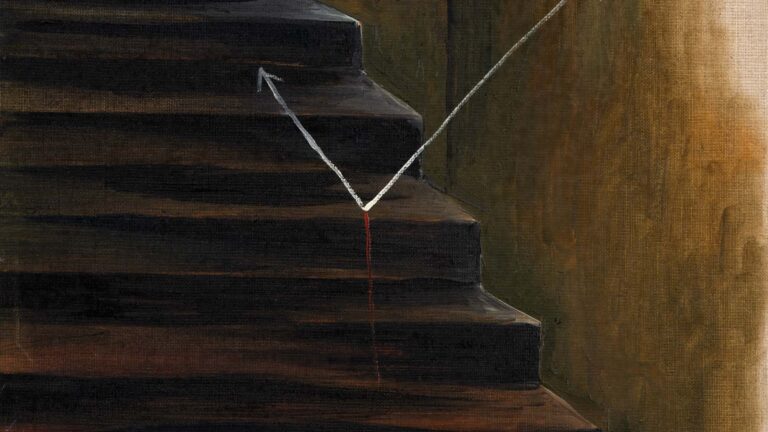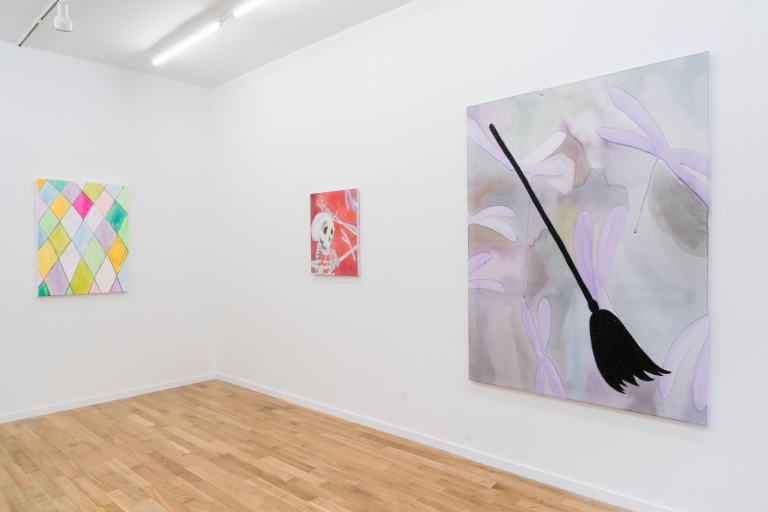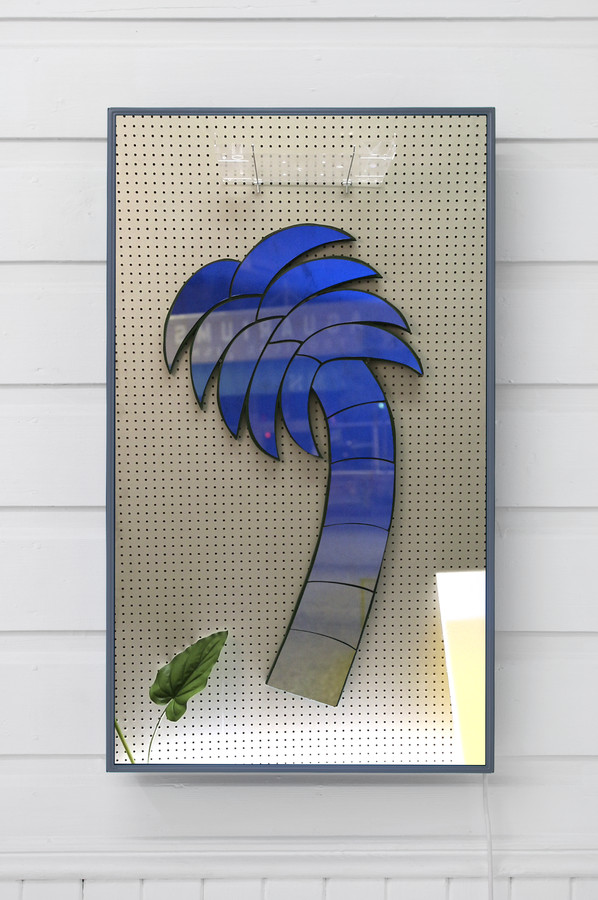Artist: Roy De Forest
Venue: Venus Over Manhattan, New York, US
Date: March 3 – May 10, 2020
Photography: all images copyright and courtesy of the artist and Venus Over Manhattan, New York
(New York, NY) – Venus Over Manhattan is pleased to present an exhibition of work by Roy De Forest, organized in collaboration with the Roy De Forest Estate. Following the recent retrospective of his work, “Of Dogs and Other People: The Art of Roy De Forest,” organized by Susan Landauer at the Oakland Museum of California, the exhibition marks the largest presentation of De Forest’s work in New York since 1975, when the Whitney Museum of American Art staged a retrospective dedicated to his work. Comprising a large group of paintings, constructions, and works on paper—some of which have never before been exhibited—as well as a set of key loans from the Jan Shrem and Maria Manetti Shrem Museum of Art, University of California, Davis, and the di Rosa Center for Contemporary Art, Napa, the presentation surveys the breadth of De Forest’s production. In conjunction with the presentation, the gallery will publish a major catalogue featuring a new text on the artist by Dan Nadel, along with archival materials from the Roy De Forest papers, housed at the Archives of American Art. The exhibition will be on view from March 3rd through April 25th, 2020.
Roy De Forest’s freewheeling vision, treasured for its combination of dots, dogs, and fantastical voyages, made him a pillar of Northern California’s artistic community for more than fifty years. Born in 1930 to migrant farmers in North Platte, Nebraska, De Forest and his family fled the dust bowl for Washington State, where he grew up on the family farm in the lush Yakima Valley, surrounded by dogs and farm animals. In 1950, De Forest received a scholarship to the California School of Fine Arts (now San Francisco Art Institute), where he studied under Elmer Bischoff and Hassel Smith, artists who encouraged De Forest to challenge the heroism of Abstract Expressionism. De Forest quickly became involved with San Francisco’s nascent Beat community, and supplemented his formal education with seminars, conversations, and exhibitions at venues like the King Ubu and East & West galleries, where he became close with artists Joan Brown, Manuel Neri, Jay DeFeo, Wally Hedrick, Jess, and Deborah Remington, among others. An active participant in the boisterous atmosphere fostered by his teachers and peers, De Forest “developed a kind of opposition to […] quasi-religious attitudes toward painting” and became “skeptical about all the Romanticism and especially the overt conversions people were supposed to go through.” His earliest works feature large skeins of bright color, which he paired with fanciful titles that undercut the heady moralism and spiritual excesses of Abstract Expressionism.
De Forest worked as an art handler at the San Francisco Museum of Art (now SFMoMA), and after an injury sustained when a Herbert Ferber sculpture fell on him, he returned to the Yakima Valley, where he spent two formative years codifying his signature style. He produced dazzling paintings and works on paper, developing a visual vocabulary that recalled his diverse interests, including natural forms like seed pods and protozoa, articles from Scientific American, and beaded tapestries from the indigenous Yakama Nation. He started using acrylic paint, whose adhesive properties he put to use in hybrid, wall-hung constructions of wood and found objects, which incorporated animals and figurative imagery for the first time. His trademark dots—Hershey Kiss like dabs of acrylic squeezed directly from the tube—emerged during this period, and many of his paintings appear to depict aerial views of vast, dotted landscapes, which he described as “more or less what you’d think of when you see a landscape from an airplane.” De Forest returned to California’s burgeoning artistic community in 1960, and mounted a series of successful solo exhibitions at the legendary Dilexi Gallery. In 1965, he joined the faculty at the University of California, Davis, which became a hotbed of creative experimentation. Alongside his colleagues Robert Arneson, Manuel Neri, Wayne Thiebaud, and William T. Wiley, De Forest fostered a renaissance of unconventional artistic production, whose exponents called their movement “Nut Art.” Bound chiefly by their joyous, rampant idiosyncrasies, more than twenty artists eventually exhibited under the banner of Nut Art, including De Forest, Arneson, Clayton Bailey, David Gilhooly, Gladys Nilsson, Jim Nutt, Maija Peeples-Bright, and Karl Wirsum. De Forest’s paintings grew increasingly figurative, featuring his signature menagerie of unusual dogs rendered in a “crazy quilt” style, where pockets of deep space punctuate the picture plane. In 1974, the San Francisco Museum of Art organized a retrospective his work, which traveled to the Whitney Museum of American Art the next year.
In the years following his retrospective, drawing came to play a more central role in De Forest’s production, and he would often put aside painting for lengths of time to focus exclusively on drawing, represented in this exhibition by a large group of works on paper. His compositions featured ever more animated canines and figures, situated in landscapes that suggest imaginative adventure narratives. Toward the end of the 1980s, De Forest began making complex sculptural frames for his paintings and works on paper that extended his imagery beyond the picture plane, often enhancing the sense of whimsy found in his compositions. Referencing the strategies of his earlier constructions, the frames led to even larger wall-mounted assemblages, like One Life to Lead, from 1986, a monumental sculpture that extends De Forest’s imagery nearly two feet off the wall. Often missed for the sheer likability of his subject matter and color palette, the rigor of De Forest’s practice and his mastery of technique is far too little discussed. This group of work charts the persistence of De Forest’s entirely unique vision, featuring examples from the earliest moments of his career to the years before his death in California in 2007.
ABOUT ROY DE FOREST
Roy De Forest was born in North Platte, Nebraska, in 1930. He attended the California School of Fine Arts (now the San Francisco Art Institute), and San Francisco State College, where he received his B.A. in 1953, and his M.A. in 1958. His work has been the subject of numerous solo presentations both stateside and abroad, including exhibitions at the Oakland Museum of California; Galerie Darthea Speyer, Paris; ICA Boston; SFMoMA; Whitney Museum of American Art, New York; Candy Store Gallery, Folsom; and Dilexi Gallery, San Francisco. De Forest’s work is frequently featured in major group exhibitions, including recent presentations at the Jan Shrem and Maria Manetti Shrem Museum of Art, University of California, Davis; National Gallery of Art, Washington, D.C.; High Museum of Art, Atlanta; Matthew Marks Gallery, New York; RISD Museum, Providence; Yale University Art Gallery, New Haven; and Museum of Fine Arts, Boston. His work is held in numerous public collections around the world, including the Centre Georges Pompidou, Paris; Christchurch Art Gallery, Christchurch; Musée cantonal des Beaux-Arts, Lausanne; SFMoMA; and Whitney Museum of American Art, New York. De Forest lived and worked in Port Costa, California, before his death in 2007.
Roy De Forest, 2020, exhibition view, Venus Over Manhattan, New York
Roy De Forest, 2020, exhibition view, Venus Over Manhattan, New York
Roy De Forest, 2020, exhibition view, Venus Over Manhattan, New York
Roy De Forest, 2020, exhibition view, Venus Over Manhattan, New York
Roy De Forest, 2020, exhibition view, Venus Over Manhattan, New York
Roy De Forest, 2020, exhibition view, Venus Over Manhattan, New York
Roy De Forest, 2020, exhibition view, Venus Over Manhattan, New York
Roy De Forest, 2020, exhibition view, Venus Over Manhattan, New York
Roy De Forest, 2020, exhibition view, Venus Over Manhattan, New York
Roy De Forest, 2020, exhibition view, Venus Over Manhattan, New York
Roy De Forest, 2020, exhibition view, Venus Over Manhattan, New York
Roy De Forest, 2020, exhibition view, Venus Over Manhattan, New York
Roy De Forest, 2020, exhibition view, Venus Over Manhattan, New York
Roy De Forest, 2020, exhibition view, Venus Over Manhattan, New York
Roy De Forest, 2020, exhibition view, Venus Over Manhattan, New York
Roy De Forest, 2020, exhibition view, Venus Over Manhattan, New York
Roy De Forest, 2020, exhibition view, Venus Over Manhattan, New York
Roy De Forest, Untitled, 2003, Mixed media on paper with artist designed frame, 39 x 52 1/2 x 3 1/4 in (99.1 x 133.3 x 8.3 cm)
Roy De Forest, Untitled, 2003, Acrylic and mixed media on paper with artists designed frame, 42 x 48 x 5 in (106.7 x 121.9 x 12.7 cm)
Roy De Forest, Luck of the Red Dog, 1997, Acrylic, pastel, charcoal, ink, graphite and glitter on paper in artist’s frame, 35 x 39 1/2 in (88.9 x 100.3 cm)
Roy De Forest, Untitled, 1962, Mixed media on paper, 23 x 30 in (58.4 x 76.2 cm)
Roy De Forest, The Problem of James R., 1968, Latex on canvas, 64 x 64 in (162.6 x 162.6 cm). Collection of the Jan Shrem and Maria Manetti Shrem Museum of Art, University of California, Davis.
Roy De Forest, Life on the Pampas, 1962, Wood, acrylic, polyvinyl acetate, found objects, 32 1/2 x 31 1/2 x 6 in (82.5 x 80 x 15.2 cm)
Roy De Forest, Every Trapper Should Have an Indian Dog, 1960, Oil and acrylic on canvas, 67 x 69 in (170.2 x 175.3 cm). Collection of the Jan Shrem and Maria Manetti Shrem Museum of Art, University of California, Davis
Roy De Forest, In Arcadia Equus, 1977, Colored pencil on paper, framed with collage elemengs, 36 x 26 1/4 x 10 in (91.4 x 66.7 x 25.4 cm)
Roy De Forest, Untitled, 1964, Acrylic on canvas, 60 x 64 in (152.4 x 162.6 cm)
Roy De Forest, One Life to Lead, 1986, Painted wood relief, 60 x 109 1/2 x 24 in (152.4 x 278.1 x 61 cm)
Roy De Forest, Don’t Look a Brick Gift Horse in the Mouth, 1972, Acrylic on canvas, 66 1/8 x 59 7/8 in (168 x 152.1 cm)
Roy De Forest, Baja Nights, 1982, Acrylic on linen, 72 x 86 in (182.9 x 218.4 cm)
Roy De Forest, A Figure of Our Time, 1972, Polymer on canvas, 65 x 65 in (165.1 x 165.1 cm)
Roy De Forest, Campfire by Moonlight, 1986, Signed, titled, dated, and inscribed on verso, Acrylic on canvas in artist’s frame, 74 1/2 x 83 7/8 in (189.2 x 213 cm)
Roy De Forest, Among the Lilies, 1974, Polymer on canvas, 66 x 72 in (167.6 x 182.9 cm)
Roy De Forest, Ship at Sea, 1970, Polymer on canvas, 22 x 22 in (55.9 x 55.9 cm)
Roy De Forest, Jungle Serenade, 1987, Acrylic on canvas, 70 1/2 x 93 in (179.1 x 236.2 cm)
Roy De Forest, Drawing, 1964, Color pencil and graphite on paper, 20 x 26 in (50.8 x 66 cm)
Roy De Forest, Untitled, 1966, Color pencil and graphite on paper, 18 x 24 in (45.7 x 61 cm)
Roy De Forest, Untitled, 1979, Pencil, crayon, paint on paper in artist’s frame, 22 1/2 x 30 in (57.1 x 76.2 cm)
Roy De Forest, Untitled, 1966, Color pencil and graphite on paper, 18 x 24 in (45.7 x 61 cm)
Roy De Forest, Untitled, 1977, Pastel and graphite on paper, 20 x 26 in (50.8 x 66 cm)
Roy De Forest, Untitled, c. 1960, Color pencil and graphite on paper, 19 x 24 in (48.3 x 61 cm)
Roy De Forest, Drawing, 1976, Mixed media on paper, 22 1/2 x 30 in (57.1 x 76.2 cm)
Roy De Forest, Untitled, 1980, Mixed media on paper, 22 1/2 x 30 in (57.1 x 76.2 cm)
Roy De Forest, Drawing, 1974, Mixed media on paper, 22 x 29 in (55.9 x 73.7 cm)
Roy De Forest, Drawing, 1975, Mixed media on paper, 22 1/4 x 30 in (56.5 x 76.2 cm)
Roy De Forest, Drawing, 1976, Mixed media on paper, 22 1/2 x 30 in (57.1 x 76.2 cm)
Roy De Forest, Untitled, 1978, Mixed media on paper, 22 1/4 x 30 in (56.5 x 76.2 cm)
Roy De Forest, Painting the Big Painting, 1993, Acrylic and mixed media on canvas, 72 x 72 in (182.9 x 182.9 cm)
Roy De Forest, Texas, 2002, Acrylic, mixed media on board, wood, 48 x 42 x 12 in (121.9 x 106.7 x 30.5 cm)
Roy De Forest, Birdsong of the Working Dog, 2006, Acrylic on canvas, 62 x 64 in (157.5 x 162.6 cm)
Roy De Forest, Untitled (Panel Painting), 2005, Acrylic on panel, artist frame, 16 3/4 x 49 1/2 in (42.5 x 125.7 cm)
Roy De Forest, Pig Farm, 2000, Acrylic and vinyl on board in artist’s frame, 32 x 43 x 2 in (81.3 x 109.2 x 5.1 cm)
Roy De Forest, The Horse, 2000, Acrylic on board; artist’s frame, 26 x 26 x 2 in (66 x 66 x 5.1 cm)



